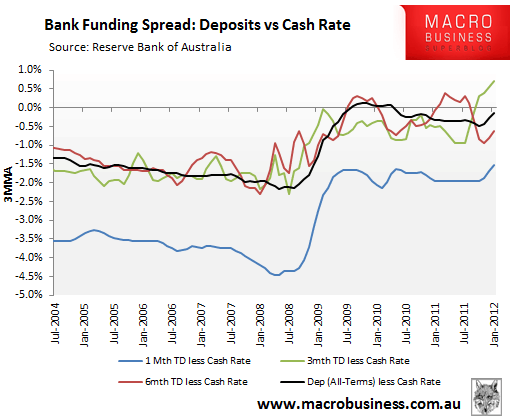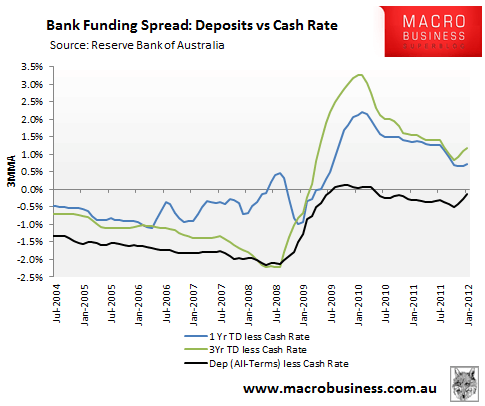By Leith van Onselen
Following on from yesterday’s post, The banks were right to lift rates, RBA Governor, Glenn Stevens, yesterday provided confirmation that Australian banks’ funding costs have increased in recent times in a Q&A session at ASIC.
In the video, Stevens notes that funding costs did not fall in line with the 50 basis point reduction in official interest rates late last year and that the banks have responded “in a way that you would expect” by increasing mortgage rates out-of-cycle.
Stevens also points viewers to the latest RBA minutes, which contains the following discussion on bank funding costs:
Members were informed that, while sentiment had generally improved, there had been a marked repricing of bank debt globally. Following the dislocation of bank debt markets globally in the latter part of 2011, issuance had picked up significantly in January, but the spreads at which bank debt was issued were significantly higher than in the middle of 2011. The Australian banks had issued sizeable amounts of covered bonds in a number of offshore markets in recent weeks at these higher spreads. Furthermore, the cost of swapping funds raised in offshore markets into Australian dollars had increased in recent months.
There had also been two large issues of covered bonds in the Australian market, which had repriced the local bank debt curve significantly higher. Over the same period, Australian banks continued to compete actively for deposits, which resulted in the reductions in most deposit rates not fully matching the recent reductions in the cash rate. Collectively, these developments had increased banks’ overall cost of funding relative to the cash rate and had narrowed the difference between banks’ lending rates and funding costs.
The high cost of raising funds on wholesale debt markets was covered in detail in yesterday’s post, so I won’t discuss it any further here. But the increased cost of deposit funding relative to the cash rate, mentioned by the RBA, is clearly shown in the below charts.
First, the spread between shorter duration term deposits and the cash rate are plotted along side the all-in (at call, term, etc) deposit spread:

Note the huge compression of spreads post Global Financial Crisis (GFC), as well as the worsening of funding costs over the past three months.
It’s a similar story for longer-maturity term deposit spreads, which are plotted below along side the all-in (at call, term, etc) deposit spread:

As argued yesterday, based on the evidence, the banks were more than justified in increasing mortgage interest rates independent of the RBA.

